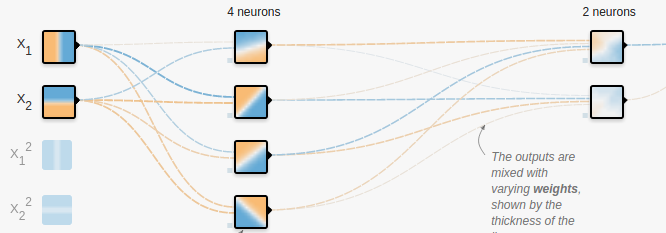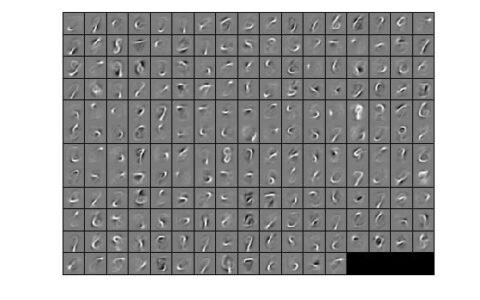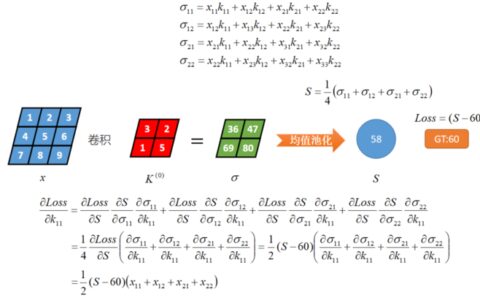本文转载自:https://blog.csdn.net/u014595019/article/details/52557623
在之前的深度学习笔记(一):logistic分类 中,已经描述了普通logistic回归以及如何将logistic回归用于多类分类。在这一节,我们再进一步,往其中加入隐藏层,构建出最简单的神经网络
2.1 大概描述和公式表达
神经网络的大概结构如图所示,

从左往右,分别是输入层,隐藏层,输出层,分别记为by. 那么根据之前logistic分类的公式稍作扩展,不难得到
其实就是两层logistic分类的堆叠,将前一个分类器的输出作为后一个的输入。得到输出by的更新
其实在上面的公式中,已经用到了链式法则。 类似的,可以得到
可以看到,在∂C∂ha 这可以看成由输出层传递到中间层的误差。那么在获得了各参数的偏导数以后,就可以对参数进行修正了
2.2 神经网络的简单实现
为了加深印象,我自己实现了一个神经网络分类器,分类效果如下图所示

上图中,左上角显示的是实际的分类,右上角显示的是分类器判断出的各点分类。靠下的图显示的是分类器的判断准确率随迭代次数的变化情况。可以看到,经过训练以后,分类器的判断准确率还是可以的。
下面是代码部分
import numpy as np
import matplotlib.pyplot as plt
import random
import math
# 构造各个分类
def gen_sample():
data = []
radius = [0,50]
for i in range(1000): # 生成10k个点
catg = random.randint(0,1) # 决定分类
r = random.random()*10
arg = random.random()*360
len = r + radius[catg]
x_c = math.cos(math.radians(arg))*len
y_c = math.sin(math.radians(arg))*len
x = random.random()*30 + x_c
y = random.random()*30 + y_c
data.append((x,y,catg))
return data
def plot_dots(data):
data_asclass = [[] for i in range(2)]
for d in data:
data_asclass[int(d[2])].append((d[0],d[1]))
colors = ['r.','b.','r.','b.']
for i,d in enumerate(data_asclass):
# print(d)
nd = np.array(d)
plt.plot(nd[:,0],nd[:,1],colors[i])
plt.draw()
def train(input, output, Whx, Wyh, bh, by):
"""
完成神经网络的训练过程
:param input: 输入列向量, 例如 [x,y].T
:param output: 输出列向量, 例如[0,1,0,0].T
:param Whx: x->h 的参数矩阵
:param Wyh: h->y 的参数矩阵
:param bh: x->h 的偏置向量
:param by: h->y 的偏置向量
:return:
"""
h_z = np.dot(Whx, input) + bh # 线性求和
h_a = 1/(1+np.exp(-1*h_z)) # 经过sigmoid激活函数
y_z = np.dot(Wyh, h_a) + by
y_a = 1/(1+np.exp(-1*y_z))
c_y = (y_a-output)*y_a*(1-y_a)
dWyh = np.dot(c_y, h_a.T)
dby = c_y
c_h = np.dot(Wyh.T, c_y)*h_a*(1-h_a)
dWhx = np.dot(c_h,input.T)
dbh = c_h
return dWhx,dWyh,dbh,dby,c_y
def test(train_set, test_set, Whx, Wyh, bh, by):
train_tag = [int(x) for x in train_set[:,2]]
test_tag = [int(x) for x in test_set[:,2]]
train_pred = []
test_pred = []
for i,d in enumerate(train_set):
input = train_set[i:i+1,0:2].T
tag = predict(input,Whx,Wyh,bh,by)
train_pred.append(tag)
for i,d in enumerate(test_set):
input = test_set[i:i+1,0:2].T
tag = predict(input,Whx,Wyh,bh,by)
test_pred.append(tag)
# print(train_tag)
# print(train_pred)
train_err = 0
test_err = 0
for i in range(train_pred.__len__()):
if train_pred[i]!=int(train_tag[i]):
train_err += 1
for i in range(test_pred.__len__()):
if test_pred[i]!=int(test_tag[i]):
test_err += 1
# print(test_tag)
# print(test_pred)
train_ratio = train_err / train_pred.__len__()
test_ratio = test_err / test_pred.__len__()
return train_err,train_ratio,test_err,test_ratio
def predict(input,Whx,Wyh,bh,by):
# print('-----------------')
# print(input)
h_z = np.dot(Whx, input) + bh # 线性求和
h_a = 1/(1+np.exp(-1*h_z)) # 经过sigmoid激活函数
y_z = np.dot(Wyh, h_a) + by
y_a = 1/(1+np.exp(-1*y_z))
# print(y_a)
tag = np.argmax(y_a)
return tag
if __name__=='__main__':
input_dim = 2
output_dim = 2
hidden_size = 200
Whx = np.random.randn(hidden_size, input_dim)*0.01
Wyh = np.random.randn(output_dim, hidden_size)*0.01
bh = np.zeros((hidden_size, 1))
by = np.zeros((output_dim, 1))
data = gen_sample()
plt.subplot(221)
plot_dots(data)
ndata = np.array(data)
train_set = ndata[0:800,:]
test_set = ndata[800:1000,:]
train_ratio_list = []
test_ratio_list = []
for times in range(10000):
i = times%train_set.__len__()
input = train_set[i:i+1,0:2].T
tag = int(train_set[i,2])
output = np.zeros((2,1))
output[tag,0] = 1
dWhx,dWyh,dbh,dby,c_y = train(input,output,Whx,Wyh,bh,by)
if times%100==0:
train_err,train_ratio,test_err,test_ratio = test(train_set,test_set,Whx,Wyh,bh,by)
print('times:{t}\t train ratio:{tar}\t test ratio: {ter}'.format(tar=train_ratio,ter=test_ratio,t=times))
train_ratio_list.append(train_ratio)
test_ratio_list.append(test_ratio)
for param, dparam in zip([Whx, Wyh, bh, by],
[dWhx,dWyh,dbh,dby]):
param -= 0.01*dparam
for i,d in enumerate(ndata):
input = ndata[i:i+1,0:2].T
tag = predict(input,Whx,Wyh,bh,by)
ndata[i,2] = tag
plt.subplot(222)
plot_dots(ndata)
# plt.figure()
plt.subplot(212)
plt.plot(train_ratio_list)
plt.plot(test_ratio_list)
plt.show()
本站文章如无特殊说明,均为本站原创,如若转载,请注明出处:深度学习笔记(二):简单神经网络,后向传播算法及实现【转】 - Python技术站

 微信扫一扫
微信扫一扫  支付宝扫一扫
支付宝扫一扫 

